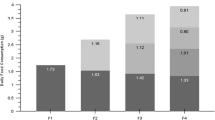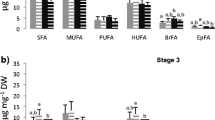Abstract
Fish embryos and larvae undoubtedly depend on maternal provisioning of essential egg components, such as fatty acids (FA), during early ontogeny. But which aspects and stages of batch-specific larval development are modulated by these inherent oocyte traits? This question is of major importance from an ecological, as well as from an aquacultural perspective. We examined the effects of batch-specific non-nuclear-genetic egg traits (fatty acid (FA) profiles, egg size, mtDNA fragmentation, cortisol content) already in unfertilized oocytes of pikeperch (Sander lucioperca) and studied their influence on survival (15 dph) and larval performance (length at hatch, stress resistance, first feeding, swim bladder inflation rate, yolk sac and lipid droplet size, growth in weight and length) after hatching under stable laboratory conditions (n = 12 batches). While larval survival and performance were independent of mtDNA fragmentation and cortisol levels, FA profiles affected specific larval traits. Especially, FA of the neutral fraction were positively correlated with larval size and growth (16:0, 18:0, 22:1n-9, total saturated FA), swim bladder inflation (arachidonic acid 20:4n-6, total FA), and early first feeding (16:0, 18:0, total saturated FA). Important FA of the polar fraction included 15:0 and 16:1n-7, which showed alternate effects on larval survival, first feeding, and growth (length). Furthermore, larval length at hatch was positively correlated with egg diameter. Other larval parameters (yolk sac and lipid droplet size and stress response) were not or only marginally affected by egg traits. Consequently, high oocyte FA deposition fuels fast rates of growth and development during early ontogeny. On the other hand, larvae develop independently of assumed disadvantageous properties (cortisol content, mtDNA damage). Knowledge of this relation allows for the improvement of aquaculture practice, as well as predicting recruitment success in the wild.

Similar content being viewed by others
Abbreviations
- ARA:
-
Arachidonic acid
- BW:
-
Body weight
- DHA:
-
Docosahexaenoic acid
- dph:
-
Day post hatch
- EPA:
-
Eicosapentenoic acid
- FA:
-
Fatty acid
- FAME:
-
Fatty acid methyl esters
- HUFA:
-
Highly unsaturated fatty acid
- MUFA:
-
Monounsaturated fatty acid
- SBI:
-
Swim bladder inflation
- SD:
-
Standard deviation
- SFA:
-
Saturated fatty acid
- SL:
-
Standard length
References
Alexeyev M, Shokolenko I, Wilson G, LeDoux S (2013) The maintenance of mitochondrial DNA integrity-critical analysis and update. Csh Perspect Biol 5
Bell MV, Henderson RJ, Sargent JR (1986) The role of polyunsaturated fatty acids in fish. Comp Biochem Physiol 83:711–719
Benôıt HP, Pepin P (1999) Interaction of rearing temperature and maternal influence on egg development rates and larval size at hatch in yellowtail flounder (Pleuronectes ferrugineus). Can J Fish Aquat Sci 56:785–794
Bobe J, Labbé C (2010) Egg and sperm quality in fish. Gen Comp Endocrinol 165:535–548
Boëchat IG, Krüger A, Chaves RC, Graeber D, Gücker B (2014) Land-use impacts on fatty acid profiles of suspended particulate organic matter along a larger tropical river. Sci Total Environ 482:62–70
Broach JS, Ohs CL, Breen NE (2017) Protracted volitional spawning of pinfish Lagodon rhomboides and changes in egg quality and fatty-acid composition throughout the spawning season. J Fish Biol 91:806–817
Brooks S, Tyler CR, Sumpter JP (1997) Egg quality in fish: what makes a good egg? Rev Fish Biol Fish 7:387–416
Czesny S, Dabrowski K (1998) The effect of egg fatty acid concentrations on embryo viability in wild and domesticated walleye (Stizostedion vitreum). Aquat Living Resour 11:371–378
Dabrowski K, Rinchard J, Czesny S, Korzeniowska M (2015) Effects of dietary levels of PUFA fed to adult yellow perch on the fatty acid composition of eggs and larvae characteristics: new research directions. In: Kestemont P, Dabrowski K, Summerfelt RC (eds) Biology and culture of percid fishes. Springer, Dordrecht, pp 565–586
Dagar A, Zilberg D, Cohen Z, Boussiba S, Khozin-Goldberg I (2010) Short-term dietary supplementation with the microalga Parietochloris incisa enhances stress resistance in guppies Poecilia reticulata. Aquac Res 41:267–277
Demska-Zakes K, Zakes Z, Roszuk J (2005) The use of tannic acid to remove adhesiveness from pikeperch, Sander lucioperca, eggs. Aquac Res 36:1458–1464
Feiner ZS, Höök TO (2015) Environmental biology of percid fishes. In: Kestemont P, Dabrowski K, Summerfelt RC (eds) Biology and culture of percid fishes, Springer, Dordrecht, pp61-100
Fernández-Palacios H, Izquierdo MS, Robaina L, Valencia A, Salhi M, Vergara JM (1995) Effect of n− 3 HUFA level in broodstock diets on egg quality of gilthead sea bream (Sparus aurata L.). Aquacultu 132:325–337
Henrotte E, Mandiki RSNM, Prudencio AT, Vandecan M, Mélard C, Kestemont P (2010) Egg and larval quality, and egg fatty acid composition of Eurasian perch breeders (Perca fluviatilis) fed different dietary DHA/EPA/AA ratios. Aquac Res 41:53–61
Hermelink B, Wuertz S, Trubiroha A, Rennert B, Kloas W, Schulz C (2011) Influence of temperature on puberty and maturation of pikeperch, Sander lucioperca. Gen Comp Endocrinol 172:282–292
Hwang PP, Wu SM, Lin JH, Wu LS (1992) Cortisol content of eggs and larvae of teleosts. Gen Comp Endocrinol 86:189–196
Izquierdo MS, Fernández-Palacios H, Tacon AGJ (2001) Effect of broodstock nutrition on reproductive performance of fish. Aquacult 197:25–42
Kamler E (2005) Parent-egg-progeny relationships in teleost fishes: an energetics perspective. Rev Fish Biol Fish 15:399–421
Kestemont P, Henrotte E (2015) Nutritional requirements and feeding of broodstock and early life stages of Eurasian perch and pikeperch. In: Kestemont P, Dabrowski K, Summerfelt RC (eds) Biology and culture of percid fishes. Springer, Dordrecht, pp 539–564
Kestemont P, Xu XL, Hamza N, Maboudou J, Toko II (2007) Effect of weaning age and diet on pikeperch larviculture. Aquacult 264:197–204
Lappalainen J, Dörner H, Wysujack K (2003) Reproduction biology of pikeperch (Sander lucioperca (L.)) - a review. Ecol Freshw Fish 12:95–106
Lubzens E, Young G, Bobe J, Cerda J (2010) Oogenesis in teleosts: how fish eggs are formed. Gen Comp Endocrinol 165:367–389
Lund I, Skov PV, Hansen BW (2012) Dietary supplementation of essential fatty acids inlarval pikeperch (Sander lucioperca); short and long term effects on stress tolerance and metabolic physiology. Comp Biochem Phys A 162:340–348
Lund I, Steenfeldt SJ (2011) The effects of dietary long-chain essential fatty acids on growth and stress tolerance in pikeperch larvae (Sander lucioperca L.). Aquac Nutr 17:191–199
Meekan MG, Fortier L (1996) Selection for fast growth during the larval life of Atlantic cod Gadus morhua on the Scotian Shelf. Mar Ecol Prog Ser 137:25–37
Milla S, Wang N, Mandiki SNM, Kestemont P (2009) Corticosteroids: friends or foes of teleost fish reproduction? Comp Biochem Physiol 153:242–251
Moodie GEE, Loadman NL, Wiegand MD, Mathias JA (1989) Influence of egg characteristics on survival, growth and feeding in larval walleye (Stizostedion vitreum). Can J Fish Aquat Sci 46:516–521
Mylonas CC, Robles R (2014) Removing production bottlenecks of emerging species for European aquaculture. Aquac Europe 39:5–15
Overton JL, Toner D, Poliҫar T, Kucharczyk D (2015) Commercial production: factors for success and limitations in European percid fish culture. In: Kestemont P, Dabrowski K, Summerfelt RC (eds) Biology and culture of percid fishes. Springer, Dordrecht, pp 881–890
Rothfuss O, Gasser T, Patenge N (2010) Analysis of differential DNA damage in the mitochondrial genome employing a semi-long run real-time PCR approach. Nucleic Acids Res 38:e24
Sargent JR, Tocher DR, Bell JG (2002) The lipids. In: Halver JE, Hardy RW (eds) Fish nutrition, 3rd edn. Academic press, San Diego, pp 181–257
Sawyer DE, Mercer BG, Wiklendt AM, Aitken RJ (2003) Quantitative analysis of gene-specific DNA damage in human spermatozoa. Mutat Res-Fund Mol M 529:21–34
Schaefer FJ (2016) Reproductive management and gamete quality in pikeperch (Sander lucioperca). Dissertation. Humboldt-Universität zu Berlin
Schaefer FJ, Overton JL, Kloas W, Wuertz S (2018b) Length rather than year-round spawning, affects reproductive performance of RAS-reared F-generation pikeperch, Sander lucioperca (Linnaeus, 1758) – insights from practice. J Appl Ichthyol 34:617–621
Schaefer FJ, Overton JL, Krüger A, Kloas W, Wuertz S (2018a) Influence of batch-specific biochemical egg characteristics on embryogenesis and hatching success in farmed pikeperch. Animal 12:2327–2334
Schaefer FJ, Overton JL, Wuertz S (2016) Pikeperch Sander lucioperca egg quality cannot be predicted by total antioxidant capacity and mtDNA fragmentation. Anim Reprod Sci 167:117–124
Schaerlinger B, Żarski D (2015) Evaluation and improvements of egg and larval quality in percid fishes. In: Kestemont P, Dabrowski K, Summerfelt RC (eds) Biology and culture of percid fishes. Springer, Dordrecht, pp 193–226
Schreck CB, Contreras-Sanchez W, Fitzpatrick MS (2001) Effects of stress on fish reproduction, gamete quality, and progeny. Aquacult 197:3–24
Steenfeldt S (2015) Culture methods of pikeperch early life stages. In: Kestemont P, Dabrowski K, Summerfelt RC (eds) Biology and culture of percid fishes. Springer, Dordrecht, pp 295–312
Stratholt ML, Donaldson EM, Liley NR (1997) Stress induced elevation of plasma cortisol in adult female coho salmon (Oncorhynchus kisutch), is reflected in egg cortisol content, but does not appear to affect early development. Aquacult 158:141–153
Tielmann M (2017) The effect of out-of-season production and light regime manipulation for intensive pike-perch (Sander lucioperca) larvae culture. Dissertation, Kiel University
Tocher DR (2003) Metabolism and functions of lipids and fatty acids in teleost fish. Rev Fish Sci 11:107–184
Trippel EA, Kraus G, Köster FW (2005) Maternal and paternal influences on early life history traits and processes of Baltic cod Gadus morhua. Mar Ecol Prog Ser 303:259–267
Wiegand MD (1996) Composition, accumulation and utilization of yolk lipids in teleost fish. Rev Fish Biol Fish 6:259–286
Žarski D, Kucharczyk D, Targonska K, Palinska K, Kupren K, Fontaine P, Kestemont P (2012) A new classification of pre-ovulatory oocyte maturation stages in pikeperch, Sanderlucioperca (L.), and its application during artificial reproduction. Aquac Res 43:713–721
Acknowledgements
We would like to thank our cooperation partner AquaPri and the members of the IGB and GMA, who have supported this study.
Funding
This study was funded by the German Research Foundation (DFG KL 745/6-1 and SCHU 2308/3-2).
Author information
Authors and Affiliations
Corresponding author
Ethics declarations
Conflict of interest
The authors declare that they have no conflict of interest.
Ethical approval
Fish rearing and reproduction were performed in accordance with EU and national legislation for animal welfare in fish production.
Additional information
Publisher’s note
Springer Nature remains neutral with regard to jurisdictional claims in published maps and institutional affiliations.
Rights and permissions
About this article
Cite this article
Schaefer, F.J., Tielmann, M., Overton, J.L. et al. Fate or independency: is batch-specific larval performance determined by egg traits? A case study in farmed pikeperch (Sander lucioperca). Aquacult Int 27, 957–969 (2019). https://doi.org/10.1007/s10499-019-00356-8
Received:
Accepted:
Published:
Issue Date:
DOI: https://doi.org/10.1007/s10499-019-00356-8




